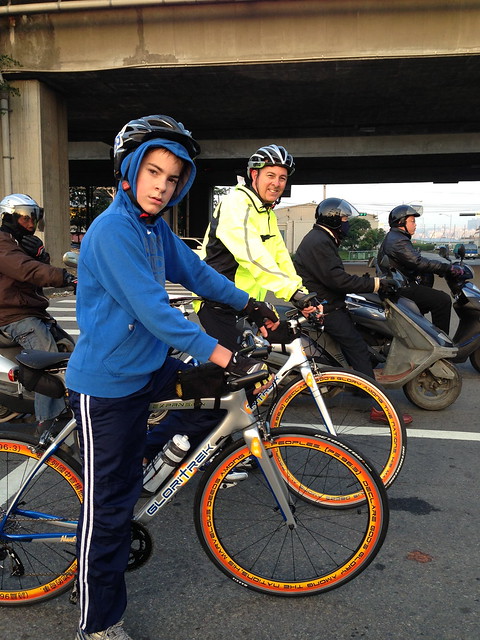
Religious Zealots in Traffic
The Taipei Times ran an editorial from the Taipei based reporter, James Baron, who brings into focus some of the problems Taipei is facing with its overlapping bicycle policies.
Baron writes:
The effort to turn Taipei into a cycle city has borne fruit.
The Guardian ran a piece called “Return of the Bicycle Kingdom? How pavement cycling is transforming Taipei” on Tuesday last week that focuses on the initiatives that have shot bicycle usage figures for the city way past those of New York and London. The author of the article, Nick Mead, who was in town for this year’s Velo-city Global Conference, heaped deserved praise on the YouBike system and the riverside cycling paths.
He also referenced a threefold increase in cycle lanes within three years, though the caveat that this extra space would be on the sidewalk and, thus, taken from pedestrians was telling. Another interesting figure was the 386.24km of sidewalk that is now apparently open in its entirety to cyclists.I also wrote some about this article Here and Here. But I don't get up to Taipei enough to see the daily interaction between bicycles, motor vehicles and pedestrians. The Guardian article seemed a bit fanciful, and not the Taipei I have encountered. But I gave the writer the benefit of the doubt is writing honestly about his experiences. I also imagined that maybe it is worse off where he hails from, making Taipei look like a city park.
One paragraph that struck me about the article was this gem:
“We want to be a cycle-friendly city, but we’re not trying to be like Amsterdam or Copenhagen,” Anne Chung, transport commissioner for Taipei, tells me on the sidelines of the VeloCity global cycling conference, which is taking place in Asia for the first time. “There are too many scooters and motorbikes at the moment and it is too dangerous to ride on the road with them, so the pavement is safer for cyclists. We want people to make cycling part of their lives and be able to combine cycling with the metro and buses for the ‘last mile’ of their journeys. We want to be able to tell car and motorbike users that there is a smarter way to get around.”But upon further investigation Baron uncovered a different story. This struck me as a bit strange, considering the occasions public officials have sought to tour the Netherlands and Copenhagen looking for inspiration for Taiwan's future development.
Possibly, one of the biggest problems may be in how the central and local governments have not been able to decide where cycling belongs. It becomes and ideological problem. Digging way back in the TiC archives I found this piece that really captures the root of the problem.
"Although the MOTC is moving to take the lead for national biking policy, projects to develop local bike paths continue to be financed by the Ministry of the Interior’s Construction and Planning Agency (CPA) and the Cabinet-level Sports Affairs Council (SAC). According to a construction plan by the SAC, a budget of NT$4 billion (US$125 million) will be devoted to the development of an integrated network of biking paths around Taiwan from 2009 to 2012, continuing similar efforts started by the council in the early 2000s for sport and recreational purposes."
You can see by the alphabet soup above, how bureaucratic divisions, budget rivalries and lack of cross-agency communication can impede the process of integrating cycling into the transportation grid. To expand on the paragraph above, it is obvious that cycling in Taiwanese officialdom is neither transportation nor a sport.The bicycle has no place to go, because bureaucrats have not been able to envision where to put it. Many see the bicycle as a piece of leisure sporting equipment-- a cash generating toy-- that is fun for non-cyclists to play with on weekend jaunts past cafes, kitsch markets, souvenir shops, and restaurants. Others see the bicycle as transportation and integral to reducing congestion in the cities.
By relegating the bicycle to the sidewalk, the city is sending the message that the bicycle is not regarded as transportation.This is a policy and an outlook that needs to be reversed for Taipei and other cities to really begin making progress. They need to provide road space for bikes and treat the bicycle as an important cog in the transportation grid rather than a mere toy.


